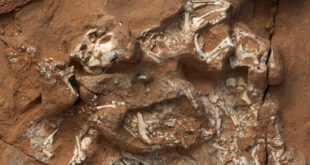Two new Early Cretaceous specimens from the Wessex Formation of the Isle of Wight, UK, represent distinct and novel genera and species of spinosaurids: Ceratosuchops inferodios and Riparovenator milnerae, according to a team of paleontologists led by the University of Southampton. Artist’s impressions of Ceratosuchops inferodios (foreground) and Riparovenator milnerae …
Read More »Bipedal Dinosaurs
The tail of bipedal non-avian dinosaurs played a role analogous to the swinging arms of humans during walking and running, according to new research led by Harvard University’s Dr. Peter Bishop. Computer simulations of running locomotion in a modern tinamou bird (brown) and the extinct theropod dinosaur Coelophysis (green). Gray …
Read More »Appalachian Dinosaurs
Chase Doran Brownstein from the Department of Ecology and Evolutionary Biology at Yale University and the Stamford Museum and Nature Center has described two new dinosaurs — a herbivorous hadrosaur and a carnivorous tyrannosaur — that lived in the North American paleolandmass Appalachia during the Late Cretaceous epoch, some 85 …
Read More »Avian Brain Shape
A team of paleontologists has digitally reconstructed the facial skeleton and brain endocast of Ichthyornis dispar, a toothed stem bird that lived in North America during the Late Cretaceous epoch and has traditionally been considered the nearest known well-understood relative of living birds. The ancestors of living birds had a …
Read More »Avian Brain Shape Dinosaurs
A team of paleontologists has digitally reconstructed the facial skeleton and brain endocast of Ichthyornis dispar, a toothed stem bird that lived in North America during the Late Cretaceous epoch and has traditionally been considered the nearest known well-understood relative of living birds. The ancestors of living birds had a …
Read More »Non Avian Dinosaurs
A new analysis of non-avian dinosaur diversity shows they were not in decline and were still capable of generating new species at the time of their extinction by the Chicxulub asteroid hit 66 million years ago (Cretaceous period). Bonsor et al. refute claim that non-avian dinosaurs were in decline before …
Read More »Soft Dinosaurs Eggs
Eggs of Earliest Dinosaurs Had Soft, Leathery Shells A team of paleontologists from the United States, Canada and Argentina has analyzed the fossilized eggs of two different non-avian dinosaurs, Protoceratops and Mussaurus, and found that the eggs resembled those of turtles in their microstructure, composition, and mechanical properties. They’ve also …
Read More »Once Horned Dinosaurs
Two New Species from New Mexico Help Fill Gap in Evolution of Horned Dinosaurs Two new transitional species of plant-eating horned dinosaurs have been unearthed in New Mexico, the United States. Navajoceratops sullivani and Terminocavus sealeyi. Image credit: Ville Sinkkonen Denver Fowler. The newly-discovered dinosaurs roamed the Earth approximately 75 …
Read More »Eggs of Non-Avian Dinosaurs Took 3-6 Months to Hatch
Non-avian dinosaur eggs took a long time to hatch — between 3 and 6 months, according to new research on the teeth of fossilized dinosaur embryos. Herds of female titanosaurs gathered at traditional nesting grounds 80 million years ago in what is now Patagonia, Argentina. Image credit: Luis Rey / …
Read More »Vegavis iaai: Dinosaurs Likely Did Not Sing, Vocal Organ of Mesozoic Bird Suggests
The oldest known syrinx (vocal organ) of a bird has been found, preserved in three dimensions in a 66-million-year-old specimen from Antarctica, according to new research led by a University of Texas at Austin paleontologist. In a Nothofagus forest on the shoreline of Vega Island, Antarctica, a mid-sized raptor dinosaur …
Read More » #Bizwhiznetwork.com Innovation ΛI |Technology News
#Bizwhiznetwork.com Innovation ΛI |Technology News









